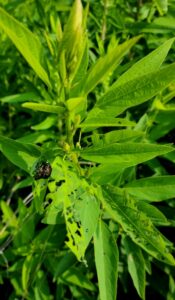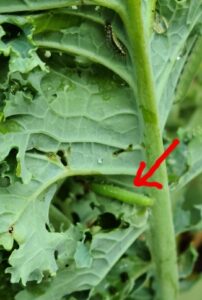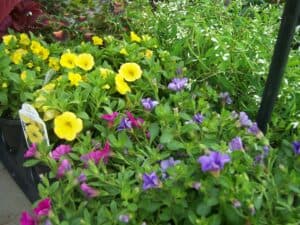By Jennifer Fairfield, owner the Garden Mill
I can’t tell you how much I appreciated the rain we saw last week. We all could have done without the high winds and other extremes that came with the rain (or the power outages for many), but I, for one, was super happy to see all that wet stuff.
I honestly thought that I had finally burned out my well pump this year because of all the watering I was doing in May and June. Fortunately, that wasn’t the case – just a bad pressure tank that was still under warranty. Thanks to the folks at Cribley Drilling Company, we were back up to full pressure in no time, which was a good thing, since the new little trees I had planted this spring really needed to be kept hydrated.
I’m betting that we are not done yet with the dry weather. Watering is especially important when the temperatures go up, which they are bound to do, since July tends to be the hottest month in Southeast Michigan, and we often go for long stretches of time in with no rain.

In the vegetable garden:
Insects are apparently plaguing lots of people’s gardens right now, based on what customers are coming in looking for these days. We have been having lots of conversations with customers about aphids especially, but also flea beetles, slugs, and other things that are eating their plants.
I’m finding cabbage moth caterpillars (pictured here) on the kale and bok choy in my veggie garden right now, along with flea beetles on my eggplants. Insecticidal soap, Neem oil, Spinosad, and Bt are among my recommendations for controlling some of the critters people are having problems with in their gardens. Each is better for dealing with different pests, so knowing what is eating your plants is important in deciding what to use to control them.
Proper timing and use of pesticides is also important, as pretty much anything you use to kill unwanted insects can also kill ones you do want, such as bees and butterflies. You should always try to spray at times when beneficial insects are not present in your garden, not spray when it’s windy out, and not spray to the point of allowing the product to drip or run off the plant you are spraying. All these steps will help ensure that you are not harming insects you don’t intend to.
Weeds tend to thrive whether or not we are getting rain, which is not a good thing because they will rob your desired plants of the moisture and nutrients they need. The best thing to do is to try to get them while they’re small, mostly because they are easier to pull out before their roots are too established.

July should be harvesting time for many crops. Normally, spring crops, such as lettuce, spinach, and peas are mostly finished producing about now, but the haze from the Canadian wildfire smoke has been keeping some of the heat of the sun at bay, so you may get an extended harvest of those plants this year. Bush beans are just now starting to produce, and pole beans should be getting going soon too, while our favorite summer crops such as zucchini, cucumbers, and early tomatoes will likely start to produce by the end of the month.
Garlic is generally ready for harvesting between mid-July and early August, depending on the variety and when it was planted (fall vs. spring). If possible, stop watering your garlic about two to three weeks before you expect to be harvesting. You can tell that it’s ready to be harvested by the foliage. When about one-third of the leaves have yellowed and withered, it’s time to check on your bulbs.
Gently wipe some of the soil away from a bulb and check the size and form of your garlic. If it looks like a good size, it’s ready to come out. If not, leave it for another few days to a week, and check again. Don’t leave garlic in the ground too long past peak harvest time though, as this could lead to rotting.
July is also a time for planting and starting new seedlings for a fall harvest. If you want to have broccoli and cabbage for fall, start your own inside by no later than July 10, transplanting the seedlings into your garden when they are four to six weeks old. They should be ready to harvest by early October. These can be good “succession crops” to be put into the garden in place of things like onions and garlic, once those have been harvested.
Around the end of the month, you can plant late season successions of lettuce, spinach, peas, beets, carrots, and Swiss chard, to be ready for picking before we see our first frosts in the fall. Radishes shouldn’t be planted until early or mid- August, as it will generally still be too hot until then for these cool-weather plants (they mature very quickly, and will bolt in the heat of Late July and early August before they can get big enough for eating).
Make sure your vegetable garden is getting the water it needs. Your plants generally need about an inch of water every week, when Mother Nature isn’t providing it. A good soaking once a week is better than a little bit every day or two, but when the temps are really high, and especially when accompanied by wind, a little more water is even better. Don’t overdo it, but definitely make sure that your soil doesn’t totally dry out between watering. That’s a great way to stress your plants.
Keep in mind that your garden’s needs may differ, depending on your soil and the type of garden. For instance, if you have mostly sandy soil, you will likely need to water more frequently. Same goes if your garden is in raised beds, like mine. I generally water every two to three days, depending on how hot it is and how much rain we are getting, because my raised beds dry out much more quickly than the clay soil around them. Knowing your garden’s water needs will help ensure healthy, happy plants.
Another way to ensure healthy, happy (and productive) plants is to make sure they are getting the nutrients they need, when they need them. Side dressing your vegetable plants with a balanced fertilizer this month will provide them with a little extra food when they need it most – as they are doing the most growing and as they are producing flowers and fruit. By the time they are ready to start putting out flowers, the plants have used up much of the available nutrition in your garden.
Providing a little more fertilizer at this point will make a big difference in whether your garden produces in abundance, which is the whole point of all the work you’re doing. The term side-dressing just means to apply fertilizer around the plant, in the root zone. Carefully work the fertilizer into the top inch or so of soil so that it doesn’t get washed away before it can break down and be useful to the plant. Apply the fertilizer about four inches from the stem of the plant, so that it’s available to the new root growth as the plant is growing and putting out more roots, and so that you don’t risk disturbing existing roots.
Keep up with your program of fungicide spraying. There are a lot of diseases that really get going as summer progresses, especially on tomatoes, cucumbers, and squash. Michigan State University Extension has already confirmed cucumber downy mildew in Michigan’s Thumb area as well as at least one West Michigan county, which means we can pretty much count on it showing up in Southeast Michigan soon. Treating your plants with an organic fungicide, such as Bonide® Revitalize Biofungicide and Safer® Garden Fungicide, on a regular basis, can help keep them from succumbing to disease, which means that you might actually get to eat a lot of what you planted. It’s important to treat your plants before you see signs of infection, because most of the diseases we see in our gardens can’t be cured once they set in.
Prevention is really the only way to keep the diseases from taking over. If you think you may already have a disease problem, but you’re not sure what it may be, Cornell University’s Vegetable MD Online is a great resource for figuring it out.
(Part two of this column will publish tomorrow.)


















